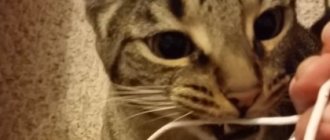Practice ALL ARTICLES 411
How often do you say “meow” to your cat? Recent studies by Hungarian scientists have shown that cat owners meow quite often when communicating with their pets - unlike dog lovers, who somehow never think of barking at dogs ;).
But meowing does not mean being able to “speak” like a cat. The cats themselves rarely talk to each other (unless there is a reason to hiss or growl at an intruder). They use their “meow” and “purr” only to communicate with people. By observing our reaction to sounds, cats learn to get what they want.
And cat language itself is a complex combination of sounds, facial expressions, posture, position of the tail and ears.
Photo: “Handsome talkative cat” by DanJLove / CC BY-NC 2.0
Language is the path to understanding
Animal psychologists say that cats make more than 100 sounds. Their volume, frequency, expressiveness, and intonation change depending on the mood of the pet. With the usual “meow” and “mur-mur” males and females actually express:
- anxiety;
- fear;
- irritability;
- impatience;
- request.
The owner needs to learn to understand their language and pay attention to their habits and behavior.
Tail
What does a cat’s tail “say”? How can you tell about a mustache's mood by looking behind its tail?
Wags its tail
Wagging the tail (i.e., the entire length of the tail moves slowly and smoothly from side to side) usually signals excitement, alertness and interest in the environment.
Swings its tail
Tail wagging (i.e. the tail moves quickly from side to side, an aggressive movement) means that the cat is agitated and irritated. Usually, when a cat does this, it takes an aggressive position. The hairs on her tail stand on end, causing it to become fluffy. In this case, it is better to leave the cat alone, otherwise you risk becoming a victim of its attack.
Twitches his tail
If a cat twitches the tip of its tail, it means that the cat is showing interest in something it sees. However, this gesture can also be the first sign of aggressive behavior, for example, if a strange cat has invaded the territory. In this case, following this gesture, the cat will begin to swing its tail and behave aggressively.
Tail shaking
This gesture is typical of cats marking their territory. Your cat may also quiver the tip of its tail when it rubs against your legs or when you scratch its back, especially near its tail. In this case, the shaking of the tail is a gesture of great affection towards you.
Tail up
If a cat holds its tail like a pistol while walking, this means that it is happy and confident. Other nonverbal cues (such as gait or gaze) will also reflect this behavior.
Tail partially tucked between legs
This gesture usually means that the cat is scared, unhappy, or feels threatened. Accompanying nonverbal gestures: ears flattened, head lowered, body pressed to the ground.
Upbringing
Cats are smart, independent and willful, and difficult to train. People usually yell at them for disobedience, and beat them for minor mischief. You won't be able to make friends with a cat if you use methods such as assault and violence. The animal will become angry and begin to take revenge on its owners.
The pet perceives the apartment or house as its territory, where everything is allowed. For this reason, cats can sharpen their claws on tables, wallpaper, and upholstered furniture. You can gently wean them off this habit using a spray bottle.
As soon as your ward is about to sharpen his claws on the furniture, you need to spray him with water from a spray bottle. You will have to repeat the procedure several times until the cat develops a conditioned reflex - without harm to the psyche and health.
Constant gentle control is equally important in raising a kitten and an adult male. For their successes, they must be praised, smiled, and gently stroked on the withers. Even animals with complex personalities thaw out after a while. It is better to reinforce prohibitions with sounds rather than shouting. This could be a palm clap. You need to talk to cats like people - they pick up intonations and over time begin to understand what the owner wants from them.
How cats show their mood
A cat's tail consists of many vertebrae and performs a large number of functions. The main role is balancing during movement and hunting. But a cat's tail is also an expression of her behavior and character. This means that if the owner is attentive and loving, then it will be easy for him to determine the cat’s mood by the tail. It is when and how a cat shakes its tail that you can understand what mood it is in.
A cat's tail twitches in different ways - both vertically and horizontally. To figure out how to understand a cat by its tail, you need to take into account many factors. These may include:
- people unfamiliar and incomprehensible to them. For older cats, this can be a stressful environment. And if this is a cat with kittens, then the trembling tail will immediately let you understand displeasure and fear for its offspring;
- general situation in the breeder’s family. If you constantly scream and at the same time can periodically hit the kitten, you should be prepared for the fact that the cat arches its back and its tail is fluffed or tucked. But when you love and cherish your pet, then his tail will almost always be a pipe, and the threat of an arched back and hissing sounds will bypass you;
- If an animal beats its tail, meows, shakes, its pupils are dilated and it tucks or arches its tail, then the pet is letting you know that it is experiencing fear. In such a situation, it is better to remove the object that provoked panic;
- An unfamiliar environment or moving can also cause displeasure in the pet, which will be expressed in the fact that the cat jerks its fifth limb. Let her know that you are looking out for her and want the best for her.
Cats can perfectly understand what you are communicating with them about. As the kitten grows up, it learns to understand its owner, and you learn how to determine its mood and how to understand your pet’s language.
Hissing and attack
Even friendly and affectionate pets can hiss at their owner, hit him with their paw, or scratch him. Nervousness and tension in an apparently calm animal is indicated by a barely noticeable twitching of the ears.
In this state, cats do not need to be touched, especially if they press their ears tightly and retract their heads. Animals behave this way when they subconsciously expect an attack. Paws and claws are part of the defense reaction. If the cat is preparing to attack first, then its ears drop almost horizontally to the sides. At this point, it is better to leave her alone until she calms down.
Your cat's habits: more and more curious
Without a doubt, cats have the strangest habits. Have you ever tried to unfold a newspaper and read it when your cat is nearby? She will immediately jump onto the table and settle down in the very center of your reading, and if only someone dares to move her! You won't be able to cheat and replace the newspaper with something else. Nor will you be able to persuade her to move to a much more comfortable pillow or chair. Why? Because while she is sitting on the newspaper, all your attention is focused on her.
If your cat rolls over onto her back and stretches out her paws, this is a sign of complete submission and trust in you. And also a demand for attention. And if she climbs onto your lap and curls up comfortably into a ball, this can hardly be interpreted other than contentment and calmness.
Rumbling and biting
When petted, animals purr, not only from pleasure. With such sounds they calm themselves and relieve internal tension. But if owners pet their pet for a long time, this is fraught with overexcitement and aggression. This manifests itself in scratching and biting.
If your pet bites your hand, you should not pull it out suddenly - you need to wait a few seconds for him to calm down. Cats perceive screams, blows and other insults acutely, take offense at people, turn away and do not respond to calls, persuasion, and appeals.
Communication with a cat: what to do so that it understands you
Cats greet each other with their noses - you can do the same. When meeting a cat, bend your index finger (like a cat's nose), squat down and slowly extend your hand with the bent finger towards the cat.
With this gesture, you give the cat the opportunity to greet you in his language. The main thing is to extend your hand slowly and at the same level as the cat's nose, and not from top to bottom.
When your cat is relaxed, slowly wink at her with both eyes and she will most likely wink back. This way you will express your trust and love to each other. By the way, the effect of “slow blinking” was scientifically confirmed in October 2020 - read about it here.
In cat language, words are not as important as intonation and gestures. If you say “fuck” or “no” in the same tone as “good pussy, eat something yummy,” then the cat will become confused about what they want from it. And don’t speak to cats in a loud voice—loud sounds scare them.
To stop your cat from misbehaving, use a firm, authoritative tone of voice combined with clear gestures. For example, when telling a cat to “get off,” make a stern face and point down with one hand.
To call your cat for dinner, praise or invite him to your arms, use a higher, kinder and “childish” voice, smile and beckon him to you.
If a cat demands attention when you are busy, then it needs to be firmly told “no” and gently pushed away. The cat doesn't care about a person's personal space, so you'll have to repeat this several times before it leaves you alone. But if you say “no” and pet the cat, it will regard your actions as encouragement and will continue its pestering.
Most cats respond to a sharp hiss as a “no” command. Therefore, cat hooliganism can be stopped with a sharp hiss.
If you constantly use the same correct intonation, facial expressions and gestures, then cats will not have problems understanding your intentions. The main thing is that the more you communicate with your cat, the better you understand each other.
How do you talk to your cat? And how does your cat communicate with you?
cats and people
Comments ()
Log in to leave a comment
Conversations
Conversational communication is an effective way to learn to get along with your cat. The human voice sounds to her like foreign speech, but over time she assimilates words and sentences and reacts to them.
When addressing your pet, it is important to use a gradation of tones:
- praise by raising your voice;
- show dissatisfaction by lowering your tone.
For individuals of the cat family, such a division is understandable, so the response will appear faster.
Another important point is the repetition of phrases so that four-legged animals remember them. These could be the simplest sentences: “Hello!”, “It’s time for lunch,” “Let’s go to bed,” and dozens of similar ones. They need to be pronounced with the same intonation - it will take 2-3 weeks, and the cat will react to the phrases instantly.
Communication requires consistency and logic. Many owners make the same mistake - they pronounce the prohibitory words “no” and “no” softly, with a smile, gently stroking the fur. And cats perceive the tone and actions of the owner in their own way: it is impossible to demand understanding from them if the actions initially contradict the words.
A commanding tone is inappropriate when a person pronounces the name of a four-legged pet. The name should evoke only positive emotions, so in this case, severity and harshness in the voice are taboo. You cannot call cats for no reason, abusing their attention to please your own desires. This will result in the pets stopping responding to the owner’s call.
A few more secrets
Making friends with a female and a male is quite simple if you follow a few simple rules:
- Diversify the diet and do not skimp on the quality of feed. Dry food and canned meat contain all the necessary elements, but cats sometimes want regular table food. If the owner treats them to a piece of chicken or beef, he will demonstrate his generosity and openness.
- Clean the litter box daily (and sometimes twice a day). Cats are clean and squeamish - stale litter and a dirty litter box often cause them to relieve themselves in corners, shoes and other unexpected places.
- Humiliation, infliction of pain, frequent lifting by the scruff of the neck or paws by children with the silent connivance of parents are a common cause of stress, fear and depression in an animal. It does not go away without a trace - hormonal levels and health in general suffer.
- Cats need communication every day, so you need to talk to them, play with them, scratch them so that they don’t feel lonely.
The owner should associate the pets with safety - as soon as they feel this, the ice of mistrust will melt and understanding will appear.











